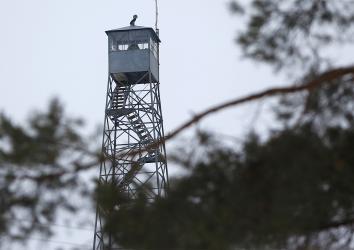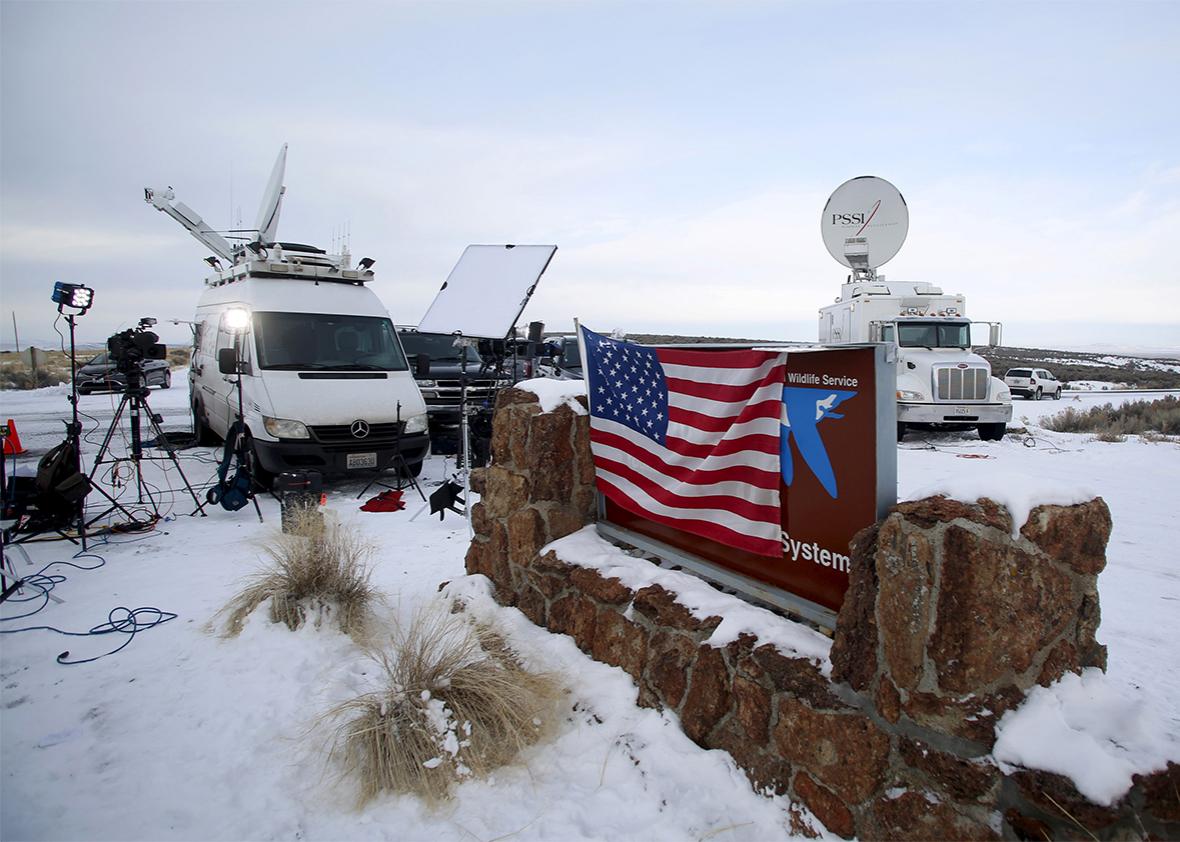In April 2014, Nevada rancher Cliven Bundy made headlines when he (and his armed allies) stood off against federal law enforcement in a dispute over private grazing and public lands. On Saturday, his son Ammon Bundy did the same. But this time, the standoff is in Oregon, over land that has nothing to do with the younger Bundy.
This Bundy—along with an unknown number of armed militiamen—have seized and occupied the headquarters of the Malheur Wildlife Refuge near Burns, Oregon, on behalf of two local ranchers, Dwight and Steven Hammond. In 2012, both Hammonds were convicted of committing arson on public lands after a decade of legal battles over fires started in 2001 and 2006. The federal government owns three-quarters of the land in Harney County, where the Hammonds reside, and its land sits near theirs. The first fire, according to the Hammonds, was a burn meant to remove invasive juniper from public land near their ranch. But federal prosecutors say this was a cover. The real reason, they argued, was to cover up evidence of the illegal slaughter of deer. A second fire in 2006 violated a citywide burn ban, and threatened the lives of volunteer firefighters in the region.
In 2010, prosecutors indicted the father and son on federal arson charges, and in 2012, they received a five-year sentence under the federal Antiterrorism and Effective Death Penalty Act of 1996.* In appeal, lawyers for the Hammonds argued that the mandatory minimum for arson under the law was unconstitutional “cruel and unusual punishment,” and a trial court agreed, reducing the sentence. Last October, however, an appeals court struck the prior ruling and reimposed the mandatory sentence, with credit for time served. After spending months in prison, the Hammonds had to return to serve the rest of their sentences.
Which brings us back to Ammon Bundy. Both Nevada and Oregon are states where the federal government owns and manages huge swaths of land. And in those places, right-wing and anti-government activism is often centered on land-use disputes. Indeed, there’s a long history of political conflict over public land. The “Sagebrush Rebellion” of the 1970s and 1980s, for example, pitted western ranchers, miners, and other private actors against the Bureau of Land Management over land that was newly marked for conservation and other public use. Ammon Bundy, like his father, comes out of the same milieu that spurred the Sagebrush Rebellion and continues to inspire resistance to federal land control.
The Hammonds, then, are a cause célèbre for Bundy and his supporters (which include his brother, Ryan), who intend to make a stand even as the Hammond family declines their assistance. “What we’re doing is not rebellious. What we’re doing is in accordance with the Constitution, which is the supreme law of the land,” he said on Saturday. “We’re out here because the people have been abused long enough, their lands and their resources have been taken from them to the point that it is putting them literally into poverty,” said Bundy to reporters on Sunday. The group has weapons, and as Bundy told CNN, “If force is used against us, we would defend ourselves.” His goal is to turn this federal land over to local ranchers, loggers, and other interests.
Because we live in an age of immediate amplification—and because this involves a Bundy—the Oregon standoff is a national political story. But these issues are hyper-regional (and a little esoteric) and don’t lend themselves to quick soundbites and instant reactions. You see this in the measured responses from Sens. Rand Paul and Ted Cruz, who commiserated with the Cliven Bundy ranchers in the past. “Every one of us has a constitutional right to protest, to speak our minds, but we don’t have a constitutional right to use force and violence and to threaten force and violence on others,” Cruz told reporters on Monday. “I’m sympathetic to the idea that the large collection of federal lands ought to be turned back to the states and the people, but I think the best way to bring about change is through politics,” said Paul to the Washington Post.
If there’s a broad issue to come out of the Oregon standoff, it’s around the use of force. As with Cliven Bundy, local and federal law enforcement has taken a wait-and-see approach to Ammon Bundy and his militia supporters. The FBI has called for a “peaceful resolution” to the confrontation, and announced its concern for the safety of “both those inside the refuge as well as the law enforcement officers involved.”

Photo by Jim Urquhart/Reuters
To observers on Twitter, this caution was galling, especially after a year of highly visible police violence against unarmed black Americans and political fear-mongering over Muslim refugees to the United States. “Let’s be clear,” said columnist Cenk Uygur, “If Muslims had seized a federal building, they’d all be dead by now #whiteprivilege #OregonUnderAttack.” Likewise, thousands of people retweeted an image of an armed militiaman captioned “150 armed white men take over a federal building and threaten violence if removed—Not a single shot is fired at them” followed by a photo of Tamir Rice with the caption, “12-year-old black boy plays with a toy gun—is gunned down in less than two seconds without as much as a warning.”
It’s easy to see why both tweets struck a chord. But it’s also worth noting the extent to which the Rice shooting—and many others—are fundamentally different from that of a standoff between armed fanatics and federal law enforcement. It’s not just that these are different organizations—local and city police forces versus the FBI and other federal agencies—and different kinds of confrontations with different procedures, but that there’s also a different history involved. Confrontations at Ruby Ridge and in Waco, Texas, ended with scores of dead (white) civilians, and inspired the Oklahoma City bombing—the deadliest terrorist attack on American soil prior to Sept. 11, 2001.
Law enforcement has been willing to use lethal violence against armed white protesters and the results were catastrophic. It’s no surprise federal agents are cautious; they walk with the hard-learned lessons of the 1990s. Even if the Bundys are paper tigers, no one wants to relive the past. In that, law enforcement officials are correct.
In any case, why won’t they shoot at armed white fanatics isn’t just the wrong question; it’s a bad one. Not only does it hold lethal violence as a fair response to the Bundy militia, but it opens a path to legitimizing the same violence against more marginalized groups. As long as the government is an equal opportunity killer, goes the argument, violence is acceptable.
But that’s perverse. If there’s a question to ask on this score, it’s not why don’t they use violence, it’s why aren’t they more cautious with unarmed suspects and common criminals? If we’re outraged, it shouldn’t be because law enforcement isn’t rushing to violently confront Bundy and his group. We should be outraged because that restraint isn’t extended to all Americans.
*Correction, Jan. 6, 2016: This article originally misidentified Dwight and Steven Hammond as brothers. They are father and son. (Return.)
